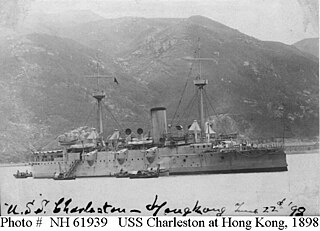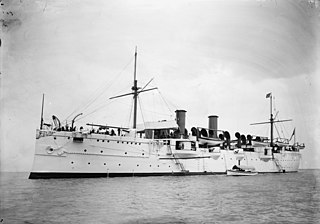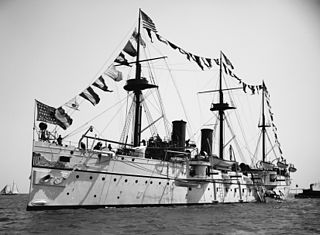 W
WThe Cincinnati-class cruisers were two small protected cruisers built for the United States Navy in the early 1890s. They were smaller and more lightly armed and protected than most previous US cruisers, and were intended for commerce raiding. They may also be referred to as Raleigh-class cruisers, as Raleigh was launched and commissioned prior to Cincinnati.
 W
WThe Columbia-class cruisers were two protected cruisers constructed in 1890 and 1891 and used by the United States Navy. They were lightly gunned ships with only moderate armor that were built for the speed needed to overtake and destroy the fast ocean liners of the day as commerce raiders. However, the light armament and armor left these ships over-specialized and outclassed by ordinary similar sized protected cruisers that they might encounter. Also, the engines were expensive to operate and at full power the ships' range was greatly decreased. Due to the ongoing size and speed race in ocean liners, by 1907 they were outclassed in speed by the ill-fated Lusitania and the German liner Kronprinzessin Cecilie.
 W
WThe Montgomery-class cruisers were three unprotected cruisers built for the United States Navy in the early 1890s. They had a thin water-tight protective deck, and also relied for protection upon their coal bunkers, cellulose packing, and numerous compartments. Roomy accommodations were provided for officers and crew, these cruisers being mainly intended for long cruises on distant stations.
 W
WThe fourth USS Baltimore (C-3) was a United States Navy cruiser, the fifth protected cruiser to be built by an American yard. Like the previous one, Charleston, the design was commissioned from the British company of W. Armstrong, Mitchell, and Company of Newcastle. Baltimore was an all-around improvement on Charleston, somewhat larger with more guns, thicker armor, and better machinery.
 W
WThe fifth USS Boston was a protected cruiser and one of the first steel warships of the "New Navy" of the 1880s. In some references she is combined with Atlanta as the Atlanta class, in others as the Boston class.
 W
WThe second USS Brooklyn (ACR-3/CA-3) was the third United States Navy armored cruiser, the only one to be named at commissioning for a city rather than a state.
 W
WThe second USS Charleston (C-2) was a United States Navy protected cruiser — the fourth US protected cruiser to be built. Lacking experience in building steel cruisers, the design was purchased from the British company Armstrong, Mitchell and Co. of Newcastle, the construction to be by an American shipyard. In design, she succeeded the "ABC" cruisers Atlanta, Boston, and Chicago with better protection, higher speed, and similar armament.
 W
WThe first USS Chicago was a protected cruiser of the United States Navy, the largest of the original three authorized by Congress for the "New Navy". One of the U.S. Navy's first four steel ships.
 W
WUSS Cincinnati (C-7) was a protected cruiser and the lead ship of the Cincinnati-class cruiser for the United States Navy. She was launched on 10 November 1892 by New York Navy Yard; sponsored by Miss S. Mosby; and commissioned on 16 June 1894, Captain Henry Glass in command. She was the second ship to be named after Cincinnati, Ohio.
 W
WThe fourth USS Columbia (C-12/CA-16) was a protected cruiser in the United States Navy during the Spanish–American War and World War I. She was the lead ship of her class of two cruisers; her sister ship was Minneapolis (C-13). The class was originally designed with three funnels; however, Columbia was built with four and Minneapolis with two. This may have been to make them resemble specific passenger liners.
 W
WUSS Detroit (C-10) was a Montgomery-class unprotected cruiser of the United States Navy which was authorized by an Act of Congress in September 1888. Detroit was launched on 28 October 1891 at Columbian Iron Works, Baltimore, Maryland, sponsored by Miss F. Malster. The cruiser was commissioned on 20 July 1893 with Commander Willard Herbert Brownson in command. It was the third ship to be named for Detroit, Michigan.
 W
WUSS Isla de Luzon was a former Spanish Navy second-class protected cruiser of the same name, captured by and commissioned into the U.S. Navy as a gunboat.
 W
WThe second USS Marblehead (C-11/PG-27) was a Montgomery-class unprotected cruiser in the United States Navy, authorized in the naval appropriations bill of September 7, 1888. Marblehead served in the Spanish–American War and World War I, and was the last ship of her class in service.
 W
WThe first USS Minneapolis (C-13/CA-17) was a United States Navy Columbia-class protected cruiser. She was named for the city of Minneapolis, Minnesota.
 W
WUSS New Orleans was a United States Navy protected cruiser of the New Orleans class.
 W
WThe New Orleans class of protected cruisers of the United States Navy consisted of two ships which were building for the Brazilian Navy at Elswick, near Newcastle Upon Tyne, England, by Armstrong Whitworth. The Brazilian Navy had ordered four Elswick cruisers, but had already sold the first ship during construction to Chile as Ministro Zenteno. One ship was delivered to Brazil, named Almirante Barroso. The third ship was fitting out as Amazonas, and the fourth was on order as Almirante Abreu.
 W
WUSS New York (ACR-2/CA-2) was the second United States Navy armored cruiser so designated; the first was the ill-fated Maine, which was soon redesignated a second-class battleship. Due to the unusually protracted construction of Maine, New York was actually the first armored cruiser to enter U.S. Navy service. The fourth Navy ship to be named in honor of the state of New York, she was later renamed Saratoga and then Rochester. With six 8-inch guns, she was the most heavily armed cruiser in the US Navy when commissioned.
 W
WThe first USS Newark (C-1) was a United States Navy protected cruiser, the eighth protected cruiser launched by the United States. In design, she succeeded the "ABC" cruisers Atlanta, Boston, and Chicago with better protection, higher speed, and a uniform 6-inch gun armament. Four additional protected cruisers were launched for the USN prior to Newark.
 W
WUSS Olympia (C-6/CA-15/CL-15/IX-40) is a protected cruiser that saw service in the United States Navy from her commissioning in 1895 until 1922. This vessel became famous as the flagship of Commodore George Dewey at the Battle of Manila Bay during the Spanish–American War in 1898. The ship was decommissioned after returning to the U.S. in 1899, but was returned to active service in 1902.
 W
WThe fourth USS Philadelphia (C-4) was the sixth protected cruiser of the United States Navy. Although designed by the Navy Department, her hull was similar to the preceding British-designed Baltimore, but Philadelphia had a uniform main armament of twelve 6-inch guns.
 W
WUSS Raleigh (C-8) was a United States Navy protected cruiser of the Cincinnati class, commissioned in 1894 and in periodic service until 1919.
 W
WSS Saint Paul was a trans-Atlantic ocean liner named for the capital of Minnesota.
 W
WThe first USS San Francisco (C-5) was a steel protected cruiser in the United States Navy. She was later named Tahoe and then Yosemite, becoming the third US Navy ship to bear the name Yosemite. She generally resembled her predecessor Newark, with a main armament of twelve 6-inch guns.
 W
WUSS Vesuvius, the third ship of the United States Navy named for the Italian volcano, was a unique vessel in the Navy inventory which marked a departure from more conventional forms of main battery armament. She is considered a dynamite gun cruiser and was essentially an operational testbed for large dynamite guns.